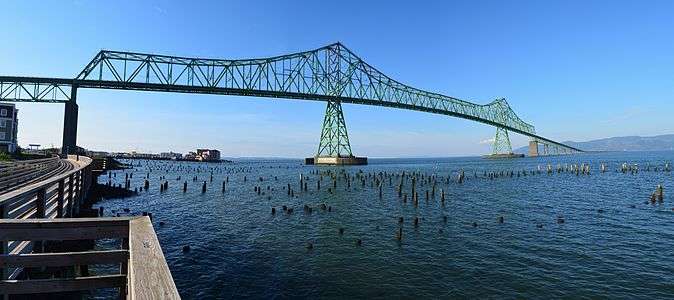Astoria–Megler Bridge
| Astoria–Megler Bridge | |
|---|---|
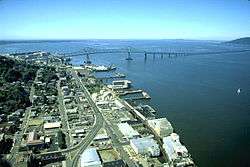 Looking west over Astoria in 1986 | |
| Coordinates | 46°13′01″N 123°51′47″W / 46.217°N 123.863°WCoordinates: 46°13′01″N 123°51′47″W / 46.217°N 123.863°W |
| Carries |
2 lanes of and bicycles |
| Crosses | Columbia River |
| Locale | Astoria, Oregon / Pacific County, Washington, USA |
| Maintained by | Oregon DOT |
| ID number | s0000548 |
| Characteristics | |
| Design | cantilever through-truss |
| Material | steel |
| Total length | 4.067 miles (6.55 km) |
| Width | 28 feet (8.5 m) |
| Longest span | 1,233 feet (376 m)[1] |
| No. of spans |
8 (main) 33 (approach)[2] |
| Piers in water | 171 |
| Clearance below | 196 feet (60 m) at high tide |
| History | |
| Designer | Oregon and Washington transportation departments |
| Construction start | November 5, 1962 |
| Construction end | August 27, 1966 |
| Construction cost | $24 million |
| Inaugurated | August 27, 1966 |
| Opened | July 29, 1966 |
| Replaces | Astoria–Megler Ferry |
| Statistics | |
| Daily traffic | 7100 |
| Toll | none (since December 1993) |
The Astoria–Megler Bridge is a steel cantilever through truss bridge in the northwest United States that spans the lower Columbia River, between Astoria, Oregon, and Point Ellice near Megler, Washington. Opened 52 years ago in 1966, it is the longest continuous truss bridge in North America.
Located fourteen miles (23 km) from the mouth of the river at the Pacific Ocean, the bridge is 4.067 miles (6.55 km) in length,[3] and was the final segment of U.S. Route 101 to be completed between Olympia, Washington, and Los Angeles, California.[4]
History
Ferry service between Astoria and the Washington side of the Columbia River began in 1926.[5] The Oregon Department of Transportation purchased the ferry service in 1946. This ferry service did not operate during inclement weather and the half-hour travel time caused delays. In order to allow faster and more reliable crossings near the mouth of the river, a bridge was planned. The bridge was built jointly by the Oregon Department of Transportation and Washington State Department of Transportation.[6]
Construction on the structure began on November 5, 1962, and the concrete piers were cast at Tongue Point, four miles (6.5 km) upriver. The steel structure was built in segments at Vancouver, Washington, ninety miles (140 km) upriver, then barged downstream where hydraulic jacks lifted them into place. The bridge opened to traffic on July 29, 1966, marking the completion of U.S. Route 101 and becoming the seventh major bridge built by Oregon in the 1950s–60s; ferry service ended the night before.[7] On August 27, 1966, Governors Mark Hatfield of Oregon and Dan Evans of Washington dedicated the bridge by cutting a ceremonial ribbon. The four-day ceremony was celebrated by 30,000 attendees who participated in parades, drives, and a marathon boat race from Portland to Astoria.[8] The cost of the project was $24 million, equivalent to $181 million today,[9] and was paid for by tolls that were removed on December 24, 1993, more than two years early.[3]
Details
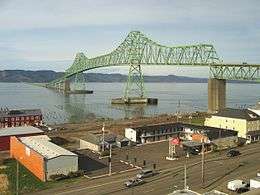
The bridge is 21,474 feet (4.0670 mi; 6.545 km) in length[10] and carries one lane of traffic in each direction. The cantilever-span section, which is closest to the Oregon side, is 2,468 feet (752 m) long,[10][11] and its main (central) span measures 1,233 feet (376 m).[1] It was built to withstand 150 mph (240 km/h) wind gusts and river water speeds of 9 mph (14 km/h).[4] As of 2004, an average of 7,100 vehicles per day use the Astoria–Megler Bridge.[12] Designed by William Adair Bugge (1900–1992), construction of the cantilever truss bridge was completed by the DeLong Corporation, the American Bridge Company, and Pomeroy Gerwick.[1]
The south end is located at 46°11′13″N 123°51′14″W / 46.187°N 123.854°W beside what used to be the toll plaza, at the end of a 2,130-foot (650 m)[13] inclined ramp which goes through a full 360° loop while gaining elevation to clear the channel over land. The north end is at 46°14′28″N 123°52′30″W / 46.241°N 123.875°W and connects directly to SR 401. Since most of the northern portion of the bridge is over shallow, non-navigable water, it is low to the water.
Repainting the bridge was planned for May 2009 through 2011 and budgeted at $20 million, to be shared by the states of Oregon and Washington.[14] However, a four-year planned paint stripping and repainting project is planned for March 2012 through December 2016.[15]
Pedestrians
Normally, only motor vehicles and bicycles are allowed on the bridge—not pedestrians.[16][17] However, one day a year, usually in October, the bridge is host to the Great Columbia Crossing.[18][19] The event uses the bridge to cross the river. and the entire route is six miles (10 km). Participants are taken by shuttle to the Washington side, from where they run or walk to the Oregon side. Motor traffic is allowed to use only one lane (of two lanes) and is advised to expect delays during the two-hour race. For the first time, the Oregon Department of Transportation has announced that the bridge will be closed to motor traffic during the 2018 event. [20]
Popular culture
The bridge itself is featured prominently in the movies Short Circuit, Kindergarten Cop, Free Willy, Free Willy 2, and The Goonies. It stands in for the doomed fictional Madison Bridge in Irwin Allen's 1979 made-for-TV disaster movie The Night the Bridge Fell Down.
Images
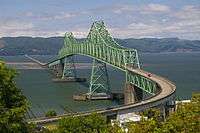 View of the bridge from Astoria neighborhood.
View of the bridge from Astoria neighborhood.- On the bridge, heading north.
- On the bridge, heading north.
- Astoria Bridge. Close up view of the through-truss section of the bridge.
 Astoria Bridge. Close up view of the through-truss section of the bridge.
Astoria Bridge. Close up view of the through-truss section of the bridge.- Astoria Bridge. Looking at the flat, continuous truss section of the bridge.
.jpg) A workman's view from high on the bridge.
A workman's view from high on the bridge.- Washington end of the bridge.
See also

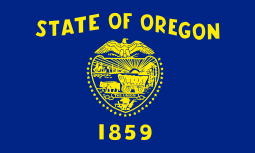

- List of bridges on U.S. Route 101 in Oregon
References
- 1 2 3 Astoria Bridge. Structurae. Retrieved on July 5, 2015.
- ↑ "National Bridge Inventory Database". Retrieved 2015-07-05.
- 1 2 "Lewis & Clark's Columbia River – 200 Years Later: Astoria–Megler Bridge". Retrieved 2013-01-25.
- 1 2 Holstine, Craig E.; Hobbs, Richard (2005). Spanning Washington: Historic Highway Bridges of the Evergreen State. Washington State University Press. p. 100. ISBN 0-87422-281-8.
- ↑ Astoria–Megler Bridge. Archived June 11, 2008, at the Wayback Machine. Astoria & Warrenton Area Chamber of Commerce. Retrieved on May 14, 2008.
- ↑ Smith, Dwight A.; Norman, James B.; Dykman, Pieter T. (1989). Historic Highway Bridges of Oregon. Oregon Historical Society Press. p. 299. ISBN 0-87595-205-4.
- ↑ "Astoria Bridge Over Columbia in Service". Statesman Journal. July 30, 1966. p. 3. Retrieved June 23, 2018 – via Newspapers.com.

- ↑ "Two Governors Officiate At Astoria Bridge Dedication". The Oregonian. August 28, 1966. p. 1.
- ↑ Federal Reserve Bank of Minneapolis Community Development Project. "Consumer Price Index (estimate) 1800–". Federal Reserve Bank of Minneapolis. Retrieved January 2, 2018.
- 1 2 "Oregon Coastal Highway Bridges". Oregon Department of Transportation. Archived from the original on July 16, 2012. Retrieved July 5, 2015.
- ↑ "Big bridge ends high over water". Lewiston Morning Tribune. (Idaho). Associated Press (& photo). October 30, 1964. p. 16.
- ↑ NBI Structure Number: 07949C009 00241. Nationalbridges.com. Retrieved on May 14, 2008.
- ↑ "Google Maps route". Retrieved 2011-11-17.
- ↑ "Astoria–Megler Bridge Painting". Archived from the original on 2011-09-29. Retrieved 2011-11-17.
- ↑ "Astoria Megler Bridge Painting - Phase 2". Archived from the original on 2012-12-14. Retrieved 2011-11-17.
- ↑ Oregon Department of Transportation: Oregon Coast Bike Route Archived May 3, 2008, at the Wayback Machine.
- ↑ Cool Ship Watching Spots On the Lower Columbia
- ↑ passport2oregon.com: Astoria
- ↑ http://www.greatcolumbiacrossing.com/
- ↑ Bridge closure for Great Columbia Crossing: Daily Astorian
External links
| Wikimedia Commons has media related to Astoria-Megler Bridge. |
- Historic American Engineering Record (HAER) No. OR-50, "Columbia River Gorge Bridge at Astoria, Spanning Columbia River at Oregon Coast Highway (U.S. Route 101), Astoria, Clatsop County, OR", 3 photos, 1 color transparency, 2 photo caption pages
- funbeach.com: Astoria–Megler Bridge
- oldoregon.com: Astoria–Megler Bridge
- Great Columbia Crossing

